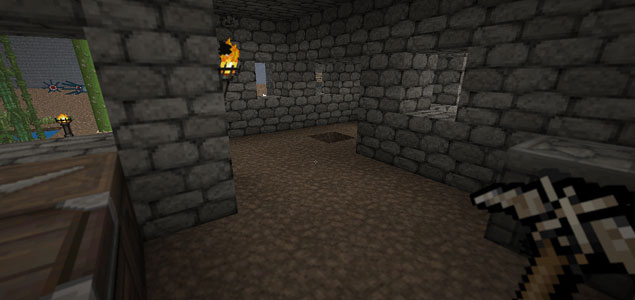
Minecraft.
Of the broad range of screens that make up our everyday life, there is only one on which you can die and be reborn. You can be honest or a villain, an alien, an artefact or a human, a winner or a loser. Only on one can you control the outcome of a fantastic world as if the complexity of the universe depended on your ingenuity and ability.
It is not the screen that defines its observer as a spectator. It is not the goggle-box used to look out at reality by the “couch potatoes” that Sartori disparagingly called homo videns: a passive mass of remotely controlled zombies. As part of the spell, the game screen exorcises the spectator from a passive role and converts him into a “gamer”, into an inter-actor. Without the actions of the player, there is no plot and no outcome: interaction is the whole point.
The game screen, now also mediated by artefacts such as Wii and Kinect, calls upon the user to intervene in the narrative in a physical and cognitive way. It forces him to think, move and gesticulate in order to lead his avatar in a world of graphic animation where everything seems possible. Things happen to the gamer’s own avatar, not to an actor with whom the gamer may identify or may not.
As with all screens, the game screen also arouses hatred and admiration, inspiring legends and certainties. If twenty years ago it was supposed that videogames only interested teenage males with disorders such as a desire for escapism, today it is possible to say that this is the most important industry in the world of entertainment, where companies such as Nintendo, Square-Enix, Ubisoft and Blizzard are disputing a throne that is constantly changing in line with the new horizons discovered by technologies and creativity. The numbers are categorical: according to the Entertainment Software Association, in 2010 alone consumers spent over 25 billion dollars on games, hardware and accessories. The average player is 37 years old and has been playing for 12 years, and the gamer community is 42% female.
Sensation and intellection are combined at the heart of the game screen, which has ably made use of all the other screens to generate its story and has brought back famous characters and feats to popular culture, from Mario Bros and Pacman to Halo, Counter Strike, Call of Duty andDead or Alive.
The game screen is the screen of 3D, that of a reinvented world that is increasingly mimetic in technical terms yet fantastic at the same time. The videogames screen shares with the advertising screen a lack of innocence in its fight to seduce. It is a recipe that cooks to perfection a world of fantasy that has much more to do with human nature than with fiction. Its producers know that those characters with large pupils and paused blinking are perceived as more sociable and attractive (D. Weibel, et al. 2009) and that gamers represented by more attractive avatars usually conduct themselves with greater self-confidence due to the so-called “Proteus Effect” (N. Yee and J. Bailenson, 2007). They know exactly in what way they must design their characters, on the basis of theories such as that of the Uncanny Valley, which explains the limits at which an animation with humanoid features generates within us tenderness and empathy or repulsion and uneasiness.
The game screen has fine-honed its success by making use of research in the world of cognitive sciences, psychology and person-computer interaction to understand the way in which we perceive, how we make decisions when we are carried away by emotion, how we learn to manage resources, to collaborate with others and even the timing relationship between sight and hand movements.
It is likely that the game screen is putting under the scientific magnifying glass some of the ideas that Hitchcock practised through intuition and Aristotle had already described centuries ago regarding narrative composition. The concepts of presence, for example, the importance of the surprise factor when managing to immerse spectators in a plot and cause a positive or negative emotional response in them.
And what is the key to seduction for this screen? A pioneer in research into games experience and design, XEODesign carried out an experiment whose results suggest that people play, not so much for the game in itself but for the experience that this creates: adrenaline highs, an imaginary adventure, a mental challenge: or the structure that the game offers, as a moment spent alone or in the company of friends. People play games to create spontaneous experiences, such as the overcoming of a difficult challenge that allows them to escape from their everyday worries, or simply to dedicate themselves to what designer Hal Barwood calls “the joy of resolving something”.
Cases of hit games such as World of Warcraft or the more recent Minecraft have shown that games exist for all kinds of gamers and motivations. It has been said that the fascination with impeccable 3D graphics and the complex plot of infinite action keeps videogame players in a world of their own. So, how does one explain such a premise when faced with phenomena such as that of Minecraft in which the idea is to construct your world made from Lego-type blocks to take refuge from impious monsters that attack at night, without any further storyline or aesthetic effort?
Games are the oldest form of education and playing is one of the vital functions of any creature with a capacity for learning. By playing we learn without realising, we experience sensations and put our intellect to the test. As Allen S. Weiss, CEO of NCH Healthcare System assures, being immersed in a videogame, having the brain stimulated, can encourage the emergence of creative solutions and adaptation to circumstances. “These ideas and thoughts can be applied to real-life situations. The results can be surprisingly positive for individuals, communities and society overall.”
While all the others screens show that some of the models upon which our world is sustained are in decline, as scenes of ecological, financial and political collapse repeat themselves, optimists exist of the stature of Jane McGonigal, who consider that games will help us change everything. For the author of “Reality is broken. Why games make us better and how they can change the world”, playing videogames is productive: it generates positive emotions, stronger social relations, a sense of achievement and satisfaction and, for those gamers that are part of a community, the opportunity to construct a sense of purpose.
For McGonigal, reality is broken and for that reason millions of people dedicate many hours each day immersed in videogames through which they achieve a sense of happiness that they cannot find in the real world. In these environments, users collaborate more and better, they become committed to resolving complex situations and make an effort to triumph. Games always make us better and could help us in the adventure of improving the world, if the fiction revolved around real-life problems such as curing cancer, fighting against hunger in the world orstopping climate change .
Thus, legions of gamers with skills that are hyper-developed thanks to hours of entertainment in the virtual world could resolve the problems that affect humanity with the skill of an expert. After all, as Malcolm Gladwell says in Outliers: the story of success, ten thousand hours of practice make a virtuoso; a teenager who plays at deactivating nuclear plants every day would end up being an expert technician in a short time. There are 8,765 hours in a year approximately; there are currently 500 million people worldwide playing online games for an hour each day. And a young user accumulates on average some 10,000 hours of training upon reaching the age of 21. This is almost the same amount of time that we spend in secondary school.
Implicit and explicit interactivity, technologically mediated alternative realities: it is thought-provoking that given the crisis of the current model, an education for the future could be configured in this way. Similarly, an increasing number of medical treatments use games in immersive environments to offer patients more attractive rehabilitation therapy. In fact, at the Pompeu Fabra University there is a project being run by research group Specs, called the Rehabilitation Gaming System, which uses games in virtual reality environments so that patients can recover mobility in their upper limbs after suffering a stroke.
We are not going to overlook the side-effects of the game screen. A brain flooded with dopamine (responsible for making gamers feel happy when they play) and with peaks of adrenaline, could develop addiction and there are still no conclusive studies explaining the relationship between violence in the virtual world and the real world. Now, as with all the other screens, the challenge lies in designing contents indicated to generate dependency and placebo or remedy and vitamins.



Leave a comment